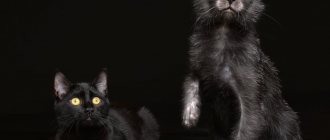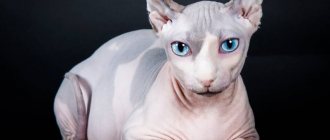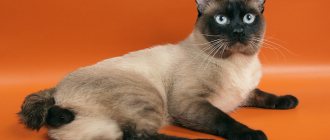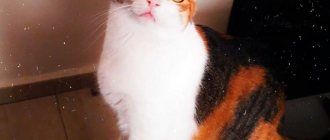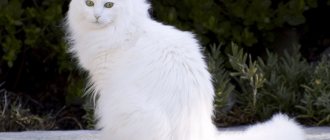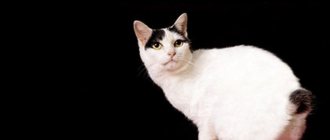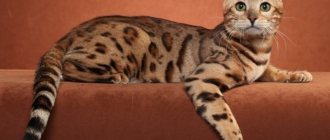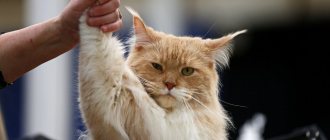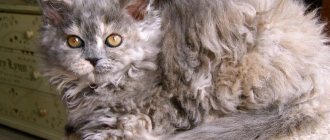It is still unclear why this cat breed deserves such a name. At the end of the 20th century, the first representatives of the Persian Chinchilla breed appeared, which did not have such a light color, but were similar in color to modern silver Persian cats. blockquote>
There is an assumption that an English breeder, by crossing a smoky cat and a silver marbled cat, opened the way for the Persian Chinchilla breed. But to achieve a beautiful light color, breeders combined Persian Chinchillas with smoky British ones. This breed gained the greatest popularity thanks to the royal granddaughter (Princess Victoria), who appreciated the incredible fur and docile nature of these felines.
Appearance
The distinctive features of the Chinchilla Persian are expressed by huge eyes and a small nose on a small fluffy muzzle. The cat attracts the attention of many because it can be quite large. A cat can weigh up to 7 kg, and its dense, thick and long hair makes its size visually even larger. The cats are more miniature (up to 4 kg), their body is correctly built, and their legs, although they have a standard length, may seem a little shorter due to their long hair.
The tail is incredibly bushy and very beautiful. The length of the hairs on it is almost 2 cm longer, if compared with the hair on the body. The color of these cats can be varied.
Color options
The following colors of Chinchilla are distinguished:
- blue;
- chocolate;
- tortoiseshell;
- red cameo;
- cream cameo;
- silver;
- golden
Recently, kittens of lilac, chocolate and tortoiseshell colors have been appearing. The fur of Chinchilla cats seems to glow from the inside, so the effect is created as if it were silver. There are also varieties of color, where part of the hair is colored blue, chocolate or tortoiseshell. Based on this, the name of the breed is formed (blue or tortoiseshell Chinchilla).
Kittens with predominantly red or cream hair color are better known as red or cream cameos. True, such colors are extremely rare. Silver and golden Chinchillas have eyes that are emerald green or a shade of sea green.
Description and features
There are plenty of exquisite cats in the world. And among the most amazing and beautiful breeds of these graceful charmers, one can highlight the silver chinchilla . It should be noted that this name was received by these cats for a very special type of plush coat with an impressive silver color.
This animal’s coat is very reminiscent of the thick fur of the cute rodent chinchilla, which has long been famous for its tenderness and play of light tints. In honor of the mentioned funny animal, this breed received its unique name.
The silver effect in such cats is created due to a light touch of dark on light fur. Visually, this gives the impression of a veil draped over the body of a four-legged creature, which also extends to the animal’s tail and its paws.
The appearance of this wonderful creature is clearly visible in the photo of a silver chinchilla . Her entire being exudes royal dignity, majestic strength and silent calm. These qualities are confirmed not only by appearance, but also by character and behavior.
Silver chinchillas have a calm character
This cat is distinguished by its flexibility, extraordinary insight and intelligence, and intellectual restraint. Such an animal does not show nervousness, does not scratch others over trifles, does not have the habit of damaging the owner’s furniture in comfortable homes, and adapts perfectly to a wide variety of conditions.
The chinchilla considers it beneath his dignity to violently express emotions: satisfaction or irritation. Natural patience gives her the ability to endure long-term loneliness. But if a beloved owner comes home, then this sweet creature will definitely find a way to express her deepest respect, devotion and love towards him.
Restraint and aristocracy are inherent in this breed even in kittens. In the morning, they tactfully wait for their patrons to wake up before rewarding them with their caresses and demanding attention and care from them. This shows the nobility of the breed.
Adult cats are incredibly smart, and even meow with a certain intonation, by which you can easily guess their thoughts, emotions and moods. Moreover, they love to communicate with their owners, which broadens their horizons and shows a desire for active improvement.
But even such domestic creatures show curiosity and activity strictly in moderation. In addition, they cannot tolerate interference from bipeds into their personal space. People can pet them, but they won’t allow themselves to be squeezed. And when they feel the need, they may well show persistent stubbornness if they see that their interests are being violated.
In this case, putting pressure on them and even persuading them is completely useless. They become attached to only one of the two-legged patrons, recognizing him as the true owner, but they love him with all the devotion of a cat’s heart.
How to care for your pet?
If a Persian chinchilla cat , the family will have to carefully comb its fur. Tangles and lumps will not only spoil the appearance of your pet, but will also give him unpleasant sensations. Therefore, the cat needs to be brushed daily. First you need to make movements along the fur, and then against it.
Also, the Persian Chinchilla cat requires careful eye care. Like other breeds with flattened faces, it suffers from excessive tearing. As a result, pathogenic bacteria may enter and retinal pathologies may develop. However, this can be avoided if the owner periodically washes the pet's eyes. For the procedure, special formulations are used that are sold in veterinary pharmacies and pet stores.
To prevent the animal's fur from turning yellow, it needs to be bathed frequently. For this, specialized shampoos are used. It is better to choose an option with a whitening effect.
In the Persian chinchilla breed, kittens are ready to move to a new home from the age of two months.
Until this moment, they must receive mother's milk so that the babies develop immunity. Newborn kittens are cared for in the same way as cubs of other breeds.
Golden chinchilla: what kind of breed?
Interestingly, golden chinchillas often differ from other cats of their breed in their smaller size and later development. They usually have a very flexible, affectionate disposition, are people-oriented, have a stable psyche, do not show aggression towards adults or children, respond adequately to external stimuli, are very sociable and are rarely vindictive.
The British Golden Chinchilla often differs from the classic representatives of the breed in having longer, silkier-feeling fur. The wayward character is usually smoothed out.
British Shorthair Golden Chinchilla (BRI-ny12)
Scottish golden cats can be fold-eared or straight-eared, short-haired or long-haired.
Scottish Golden Chinchilla (SFS-ny12)
The Persian golden chinchilla, like other Persians, has a very long, thick coat that requires complex care. Often different in character, more active, playful and affectionate.
Persian golden chinchilla (PER ny12)
Breed standards
The cat of the silver chinchilla breed stands out from the female cat with expressive cheeks, which is very striking. From birth, such creatures are endowed with a muscular large body, as well as a squat body, because such animals, in accordance with their characteristics, have short legs.
Other distinctive features of chinchillas are:
- straight back;
- wide chest;
- small neat ears on a round head;
- the eyes are round, large, bordered with black, green with turquoise or blue, sometimes amber;
- the nose is slightly flattened, wide, short, light brown in color with a border;
- neat, but widened paws;
- a thick short tail (according to standards, it should be half the size of the body);
- there should be hair on the paws between the toes;
- body hair shade is light with darkening,
- the back, as well as the tail and sides, are slightly darker than the main color background;
- the color is varied, it can be classic silver, but it can also be complemented by other impressive, original and rare shades: smoky, tortoiseshell, marble, gold, other colors, as well as their combinations and patterns;
- The length of the coat depends on the subspecies: it can be of medium size, there are short-haired specimens, but at the same time they are fluffier, and there are also long-haired chinchillas.
Features of the golden chinchilla color
Color has its own standard, and the more it meets it, the higher it is valued. The undercoat should be light apricot to golden in color. Ears, chin, belly, chest are apricot. The nose, eyes and lips are outlined in dark brown or black. The head, back, sides and tail must be sufficiently tipped with black or brown to give the required golden hue to the color. If the hairs are dyed dark for 1/3 of the length, the color is called shaded, and if it is 1/8 of the length, it is called chinchilla. Also in gold color there can be a ticked color. Such cats are darker, and each of their hairs has not one black stripe, but two or more. Sometimes tabby marks, stripes on the body, on the paws, and markings on the head characteristic of the color are visible on the gold.
The uniformity of color and the absence of a gray tint on the undercoat is highly valued. eyes are green or blue-green. The nose is red, the paw pads are black or brown.
Character of furry kings
The Chinchilla Persian is phlegmatic. The quiet voice makes it difficult for owners of breeding females to determine the onset of estrus. They rarely meow. They get along well with teenagers and small children. They tolerate the pranks of small family members relatively easily, although they cannot tolerate other animals in the house.
The Persian Chinchilla cat can catch mice, so it is suitable for both private houses and apartments. Loyal to her owner, following him throughout the entire space. However, escaping from home is practically impossible. If the owner does not want or cannot pay attention to his four-legged friend, he will occupy himself with play or simply doze off on his favorite blanket.
At the same time, Persian chinchillas are kittens with a curious disposition. They happily explore the world around them while walking with their owner on a harness. They love watching birds while sitting on the windowsill. In general, Persian chinchillas are calm and peaceful creatures. They pass this condition on to humans. Therefore, they are perfect for men and women whose work involves daily stress.
Character and habits
The main features that can be noted in the character of Persian chinchillas are calmness, unhurriedness and nobility. You can safely leave this pet at home in your absence, without fear that it will cause mayhem. Without an owner, the cat will calmly doze on the sofa or look at the landscape outside the window. At the same time, chinchillas are not devoid of natural curiosity. Not a single corner in the house will remain secret; the cat will definitely explore its home thoroughly.
In moments of playfulness, the animal will be able to entertain itself on its own; to do this, just throw a few small toys on the floor. Chinchillas move gracefully and gracefully; during their games they do not drop flower pots, vases and figurines. It is unlikely that such a cat will cause damage to the interior even unintentionally.
However, you need to be prepared for the fact that an animal that stays alone all day will require attention and affection from the owner who returns from work. Chinchillas are very friendly and quickly become attached to people. They love to follow their owner's tail or perch on his lap, purring songs.
Cats of this breed get along well with children, but they cannot tolerate other furry pets. They have a highly developed territorial instinct. When another cat or dog appears in the house, fights cannot be avoided. As befits royalty, chinchillas require maximum attention and do not want to share their owner’s love with any other animals.
Kinds
The ancestor of the breed, an original-colored cat named Shinny, was an inhabitant of Mrs. Hart’s nursery in England at the end of the 19th century. It was there that she was first discovered and noted as the owner of a special color, and then acquired by another breeder named Vallance for further breeding and producing offspring with a valuable trait - silver wool.
Further, one of Shinny's male descendants really became very famous, became the winner of many exhibitions, was awarded prizes and went down in history as the first chinchilla cat. It was for him that an exhibition class of such extraordinary cats was founded in 1894.
The first representatives of the silver chinchilla breed had a pure silver color, marked by an indeterminate tabby pattern, which is now commonly called ghostly or shadow. But they were few in number, and therefore to continue the family it was necessary to cross them with blue, smoky, and silver tabbies of different colors.
This interfered with the conservation of the breed. Therefore, the color of its representatives of those times could not be called established. The cats looked either too dark or unevenly colored. And only with an increase in the number of suitable applicants (around 1930) did the possibility of targeted selection become possible.
Initially, there was only the Persian (as it was later named) long-haired subspecies. According to color, its representatives were divided into “silver shaded” cats, too dark in color, and real chinchillas - lighter, the ends of whose hair were colored only an eighth of the total length.
Silver Chinchilla Persian
New specimens of the so-called ticked chinchillas have also appeared, that is, cats that do not have stripes or spots in their colors, whose hair is colored evenly, but differs in shade in different zones, which gives the effect of a slight shimmer and an impressive play of color.
Ticked chinchilla
The Persian subspecies still exists. Such specimens are distinguished by luxurious arctic fox fur, emerald eye color, a nose resembling a red brick, black paw pads and lips. In those days, this type was crossed with exotic and British cat breeds, which yielded results and the emergence of new subspecies.
The British silver chinchilla cannot boast of long hair, unlike its ancestors. It has a short coat, but its fur is famous for its thickness and fluffiness.
The coloring of such creatures, like other true chinchillas, is white with colored ends of the hair, a peculiar dark coating, the shade of which can be very individual in different individuals.
Green eyes with dark eyeliner stand out against the background of delightful fur, which makes them unusually expressive with such “makeup”.
The Scottish silver chinchilla was also bred from long-haired Persians . Typically, such specimens have medium-length hair, but, in fact, in terms of external characteristics they are not much different from the British, which is not surprising, because these two subspecies are very closely related. When breeding Scots, representatives of the British subspecies were used quite often.
Chinchilla ears can be erect, that is, the most common, and also strike a very original “owl” shape. Instances of the latter have ears tightly pressed to the head, repeating its outline, which are practically invisible.
A cat with a similar trait is usually called a silver fold chinchilla . These are considered especially exotic.
Kittens
The Persian breed is most active in childhood. He enthusiastically explores the apartment, attacks a fly hiding on the wallpaper, or disappears into the wilds of the country lawn, revealing ancient instincts. Early returns may be susceptible to food allergies, so try to introduce them to quality dry food.
How long do Persian cats live? Pets may be susceptible to skull deformation, eye diseases, and have breathing problems
. But one way or another, the average life expectancy is 14-15 years. There is an opinion that male Persians are more active and aggressive, while females are docile and gentle. But in reality this is far from the case. It is the female Persians who show greater independence and autonomy. You should take this fact into account when purchasing a pet.
Interesting!
The average cost of a Persian cat in the world is from 300 to 800 US dollars.
Brief history of the breed
Persian chinchillas appeared in England in the 80s of the 19th century. It is assumed that individuals with smoky and silver marbled colors were used to breed cats of this breed. There is also an opinion that in order to lighten the tone of the coat in the initial stages, the blood of the smoky British was infused into the Persian chinchillas. And a little later, individuals with a golden color appeared.
The popularization of the breed was facilitated by the fact that the docile and beautiful chinchillas attracted the attention of the granddaughter of the Queen of England, Princess Victoria. From the moment these cats settled at the palace, the British nobility became interested in them. Later, the breed spread throughout the world and is now actively bred on all continents.
Care and maintenance
These creatures, who tend to behave with true royal dignity, in everyday life turn out to be far from being as demanding and picky as it might seem at first.
A big advantage of the breed is that by nature its representatives are endowed with quite good health. However, the care and nutrition regimen should still be followed in order to protect such noble pets from troubles and diseases.
And the first point that should be noted as requiring special attention is the need to monitor the magnificent fur of such pets. Regardless of whether the cat's fur is long or short, it must be combed at least a couple of times every seven days.
The silver chinchilla's coat needs to be brushed once a week.
This procedure is undoubtedly important because excess hair negatively affects the well-being of such high-breed creatures. In addition, it is clear that wool in the house, left in different parts of the home: on furniture in rooms, carpets on the floor and clothes of the owners, does not have a positive effect on the hygiene of the room, and can also cause an allergic reaction.
Another important procedure is monthly bathing. And after this, it is recommended to examine the animal’s eyes, teeth and ears for contamination and the presence of inflammatory foci in them. This is important especially in the summer, because the heat makes it difficult for the cat to breathe and also provokes unwanted discharge in animals. What becomes a consequence of purulent inflammation.
It is better for the owner if he makes it a rule to treat such a sensitive and intelligent pet without irritation, violence, screaming and pressure. Otherwise, the reaction to injustice in a silver chinchilla cat may turn out to be the most unpredictable.
She is independent and loves freedom, and, therefore, she needs personal space - her own camphor and cozy corner for relaxation, which should be equipped with love and taking into account the animal’s personal preferences.
How to behave with chinchillas?
You can only communicate with your pet in a calm voice.
If the owner's tone is not to her liking, the cat may be offended and the owner will lose her trust.
Be sure to read:
Somali is a long-haired cat descended from the Abyssinian, description, care and cost
You need to communicate with a chinchilla only in a calm voice.
Animals appreciate attention and begin to waste away if they are not noticed, so chinchillas are not suitable for families where the owner is often absent.
Diseases
Following basic hygiene rules will reduce the risk of your pet contracting some dangerous diseases. When you come from the street, wash your hands immediately. Do not approach the cat in outerwear. The same applies to shoes: they can easily bring pathogens from the street. First of all, this applies to cats that have not yet been vaccinated.
A peculiarity of Persians is snoring during sleep. This is a feature of the body associated with congenital deformation of the nasal septum, so do not panic.
- Eye infections occur frequently in Persians. The treatment method is chosen by the veterinarian: in some cases medication is sufficient, in others only surgery will help.
- Polycystic kidney disease is the formation of cysts on the organ. Causes kidney failure. Maintenance therapy is recommended.
- Gingivitis and periodontitis are also quite common. If the disease is advanced, only tooth extraction will help.
- The special structure of the nasal passages leads to frequent colds. The cat should be protected from hypothermia: do not allow it to sit in a draft, dry its fur with a hairdryer after bathing, do not feed food from the refrigerator, and do not walk in bad weather.
- Hypertrophic cardiomyopathy is a thickening of the heart muscle. The cat begins to get tired quickly, cough, breathe heavily and moves little. It is impossible to cure the disease, but drug maintenance therapy can significantly alleviate the condition and prolong life.
- Dermatitis is characterized by the appearance of brown discharge around the nose and eyes. The hair in these areas falls out, the skin turns red and swells, which is why the cat experiences discomfort and constantly tries to scratch this area. It often spreads to the ears. Occurs mainly in young animals. Medicines can achieve remission, but without proper control the disease develops again.
Nutrition
The menu of such a cat must be varied. But in the diet it is important not to mix homemade food and artificial food, but to immediately choose one of the above. If preference is given to the latter, in this case, when choosing food, it is necessary to take into account the condition of the body, the size and weight of the pet.
Only with this approach will it be possible to select a suitable product in the store. Therefore, for advice on proper nutrition, it would be a good idea to immediately contact a veterinarian who is knowledgeable in these matters.
In general, the body of chinchilla cats is perfectly adapted to digest and accept the meat of rabbit, turkey or chicken. Moreover, such dishes can be served to your pet either boiled or raw, but it is better to cut the meat pieces for lunch into smaller pieces.
You can include fish dishes in the menu, however, not too often, because a couple of times every seven days will be more than enough. You can also give chinchillas low-fat cottage cheese, yoghurts, kefir, but again not in excessive quantities. Vegetables include cabbage and carrots, and the healthiest porridge for a cat may be buckwheat.
As for the diet, the most ideal would be two meals a day (for young cats - three times a day) meals. To ensure that the fur of a magnificent chinchilla is always in the best condition, such creatures need vitamins.
By the way, there are a lot of them in regular artificial food for kittens. However, such diets should again not be abused.
Health
In general, chinchilla cats can boast of good health. However, some hereditary diseases have not escaped them.
See also: American Shorthair cat
Polycystic kidney disease. Unfortunately, the disease is almost invisible in the early stages. In the later period of the disease, the animal’s abdomen increases in size and pain occurs.
Hypertrophied cardiomyopathy. Ultrasound will help identify the disease. The first symptoms are fatigue and shortness of breath.
Retinal atrophy. The eyes of a chinchilla are a kind of “Achilles heel” of the animal. Increased tear production and lack of regular care together can lead to complete blindness of the pet. Extremely dilated pupils and an unnatural shine in the eyes indicate that it is time to consult a veterinarian.
With proper care, the average life expectancy of chinchilla cats is twelve to fifteen years.
Reproduction and lifespan
Selecting a suitable partner for cats of this breed, if you want to get offspring with the required hair quality, is not an easy task and requires a lot of knowledge in the field of animal breeding.
The silver type color is divided into several groups:
- darkened silver (the colored tip of the hair is no more than an eighth of the length);
- ticked (with alternating several light and at least three dark zones on the hair);
- silver shaded (colored at the tip for a third of the length).
Errors in selecting pairs for mating can result in the appearance of silver chinchilla kittens with undesirable hair color. This makes it difficult for the breed to develop. And restoration of the necessary qualities takes two, or even three generations. At the same time, the progressive features of purebred chinchillas may be completely lost.
The problem is also the eye color of these cats. Initially, it was believed that in purebred representatives it must be turquoise (greenish-blue). Later, bright yellow and orange eyes were accepted as acceptable.
But although there are more than enough difficulties, however, thanks to the efforts of breeders and the hard work of breeders, the chinchilla breed is constantly being improved. And even if the kitten does not become a prize-winner at exhibitions, it still pleases its owner.
Such a sublime creature, captivating hearts at first sight, will decorate any home and easily make friends with its inhabitants. The approximate lifespan of such pets, which are naturally in good health, is approximately 15 years.
The history of the golden chinchilla
For the first time, golden kittens appeared in a litter from two Persian cats of silver chinchilla color. The spectacular fur coat immediately attracted the interest of breeders. It has not yet been possible to find the gene for golden color. Genetics have put forward a theory about a group of genes that provide additional synthesis of yellow pigment. This assumption is too vague, but satisfactory. Today, various types of bindings are used to obtain, improve and secure gold. They continue to breed two silver chinchillas, breed golden ones “in themselves” and experiment with other colors.
The golden chinchilla color first appeared and was standardized in Persian cats.
Soon British and Scottish breeders wanted a new color, and they began breeding their cats with Golden Persians. Gold looked very beautiful on a short plush coat, work on fixing the color in these breeds went even faster, and golden Britons became very much in demand. Today, many people associate the golden chinchilla color with the British Shorthair cat, although it can also be found in any other breed for which the silver chinchilla color is recognized and possible.
The use of Persian cats with such a seductive color made it possible to obtain it from British and Scottish cats.
Consequences of suppressing the natural instincts of an animal
We should not forget that such procedures (castration and sterilization) are not only beneficial, but can also cause harm. It is known that after surgery aimed at suppressing the physiological needs of a feline, animals can gain extra pounds. Therefore, such a pet’s diet will need to be monitored for the rest of its life, in order to avoid serious health problems: obesity, shortness of breath, heart failure.
In this case, the answer to the question of how long castrated cats live at home will depend entirely on the person who competently builds the right diet for the pet with a minimum content of proteins and fats.
Price
In Russia, few specialize in this breed. In total, no more than six breeders are engaged in chinchilla cats. Those who have decided to purchase a kitten of such a wonderful breed should know that representatives of its price category occupy the average.
Purebred specimens, which can subsequently be presented at exhibitions and used in breeding, will cost future owners no less than 70 thousand rubles.
There is also a cheaper category of chinchilla kittens, which are estimated at 30 thousand. As a rule, such specimens of the breed, from the point of view of experts, have some kind of flaw, and they are not intended for breeding and showing.
History of the origin of the breed
Britain is considered the homeland of the chinchilla. This is where the history of the formation of the breed begins. To obtain a unique breed, breeders had to cross the classic “British” silver dogs and “Persians”. There were also representatives of the blue shorthaired breed.
British chinchilla
A long, painstaking selection has borne fruit: cats with a unique chinchilla color began to appear. They quickly gained popularity throughout Europe.
This was the favorite breed of the Swedish Princess Victoria: only they were bred in her palace.
The age-old question regarding feeding
The lifespan of any living creature, not just a cat, is influenced by a proper diet, which ideally should be complete in all respects. Veterinarians recommend feeding your pets dry food to the exclusion of all other additives. The main rule is that the food must be premium or super-premium. According to professionals, this is the diet that can give an animal many years of a happy life.
Ordinary people: experienced breeders or those who bring a cat into their home for the first time are of the opinion that it is not better to find “live” food. Sometimes they even combine “drying” with cereals, meat or something else, considering this approach to be correct. From a scientific point of view, from such feeding the animal is slowly destroyed, not receiving the necessary nutrients and acquiring many diseases. The reason is that dry food produces certain enzymes in the pet’s stomach that are unable to digest “live” food and vice versa. Therefore, those who want to bring a small kitten into their home should study the issue of proper feeding thoughtfully and in detail.
Feeding the cat
Due to the fact that the luxurious coat of Persian chinchillas gets very dirty while eating, many breeders recommend giving these cats commercial premium or super premium dry food. When choosing drying products, it is important to pay attention to the expiration dates and composition of the assortment presented in the store. The food for Persian chinchillas should contain all the necessary vitamins and minerals. Cats of this breed eat well:
- Bosch;
- Royal Canin;
- Grandorf;
- Brit Care;
- Hills.
In contrast to those who recommend feeding chinchilla Persians with industrial food, there are also those who prefer to give their pets natural food. In this case, the cat's diet should include a sufficient amount of raw lean meat, which can occasionally be replaced with offal and ocean fish. Also, the menu of representatives of the breed should be diversified with cereals, vegetables, sour milk and quail eggs.
On a note. Persian chinchillas are very clean and often lick their coats. Therefore, it is recommended that they are regularly given a special paste to dissolve hairballs in the stomach.
In order not to undermine the health of chinchilla Persians with improper nutrition, river fish, fatty meat, confectionery, onions, potatoes, exotic fruits, sausages, canned food, pickles, smoked meats and any food from the owner’s table are completely removed from their diet.
Types of Persian cats
Persian cats were domesticated several centuries ago, and since then their appearance has undergone many changes. Thanks to breeders, today there are several types of this breed.
Depending on the color, there are about 100 varieties. Cats can have a single color, or they can consist of several colors and shades.
The most noticeable distinguishing feature in the description of a Persian cat is its nose. It is small, wide and snub-nosed. There are several types of Persian noses. Depending on its type, there are several types of Persian cats:
- Classic British - straight nose, located just below eye level
- European - snub nose, the upper edge of which is at the same level as the lower eyelids
- Extreme - snub nose, which is located on the same level with the upper eyelid.
Previously, there was another type of Persian cat - peakface. Their nose was located above the level of the upper eyelid. Their breeding was prohibited due to significant health problems
These cats have: breathing problems, constant lacrimation, malocclusion, problems eating. Such cats lived very rarely. The extreme type of Persians is the result of selection taking into account the rules of humane treatment of animals.
